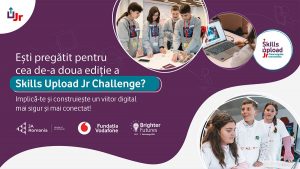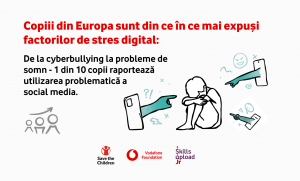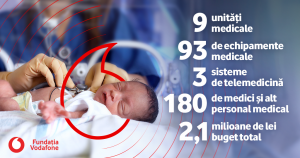Bucharest, the 27th of January 2016 – A team comprising two attending neurosurgeons, doctors Sorin Târnoveanu and Ionuț Gobej, and anaesthesiologist dr. Adriana Guriță, performed brain surgery on a 2-year old child, using a neuronavigation system.
The new system has been recently brought to the Neurosurgery Department at Marie Curie, having been purchased by the Children’s Heart Association with financial support from the Vodafone Romania Foundation. The 250.000 Euros provided by the Foundation allowed the department to acquire both the neuronavigation device, and an endoscopy column. With the same budget, the hospital will also be able to invest in an electrophysiology system. All this will make it possible for the medical team at „Maria Sklodowska Curie” Emergency Children’s Hospital to perform complex, cutting-edge neurosurgical interventions.
“This technology is the standard in paediatric neurosurgical pathology all over the world. For the children, it means smaller incisions, quick recovery, reduced hospitalisation and for us, doctors, the possibility to pinpoint the location of tumoral processes with precision, and lowering the risk of brain lesions to a minimum”, declared dr. Sorin Târnoveanu, attending physician in Neurosurgery.
For the 2-year old boy diagnosed with anaplastic ependymoma, a severe type of brain tumour, the surgery – using this computerised guiding system – was the only viable solution. The young patient, weighing only 8 kilograms, had already undergone two classic surgeries in order to remove the tumour, which measured – according to 3D imagistic investigations – 8 cm/ 7 cm/ 8 cm.
On January 13th 2015, using the neuronavigation system, Romanian doctors Târnoveanu și Gobej managed, after 240 minutes of tension, to remove the giant tumour, preserving brain function and of the surgery on cerebral structures to a minimum. Even the scalp incision the neurosurgeons performed on the little boy was small in size – only 5 cm, with a bone flap of 4 cm in diameter.
At the moment, the child is under medical supervision, undergoing specialised oncology treatment. He is the first patient with a brain tumour to be operated at Marie Curie through this minimally-invasive technology, neuronavigation. This type of intervention gives Romanian children diagnosed with brain tumours a better chance at life.
Neuronavigation is a computerised system which consists of rendering 3D imaging of the patient’s intracranial structures on a monitor. The system is actually a brain GPS, which gives the surgeon useful information about the position of his instruments.
By using this system, based on prior neuroimaging investigations (CT or MRI), the neurosurgeon can visualise in 3D the patient’s anatomy and the position of the surgical instruments relative to the patient’s cerebral structures, thus being able to excise brain tumours with a high level of precision, preserving brain function and reducing lesions.
Wide incisions are no longer necessary, because this kind of technology allows localising the tumour with a precision of less than 1 mm. Thus, very large tumours can be removed through small holes if the bone flap is positioned correctly, disengaging the tumour on all sides, without damaging the healthy tissue. Furthermore, the duration of the main operative step is reduced – in dealing with a 5 cm tumour, the surgeon always knows where he is. If he is in the centre of the tumour, he can work very quickly and the safety of the patient is significantly increased, because the surgeon knows there is no healthy tissue around that can be damaged.
In 2015, 250 children were operated in the Neurosurgery Department at the Marie Curie Hospital in Bucharest, of which 10% were diagnosed with brain tumours.
About Children’s Heart Association
Children’s Heart has been helping children suffering from heart disease, and not just them, since 2006.
The Children’s Heart Association’s main projects were conducted at the Marie Curie Hospital and included setting up the Centre of Paediatric Heart Surgery (2009 — 2011), renovating the Cardiology Department (2012), building the Neonatal Intensive Care Unit, furbishing the Neurosurgery Department (2015).
In 2016, Children’s Heart sets out to organise more medical missions, so that more children can be operated at the Marie Curie Heart Surgery Centre. Also this year, the Association will open the first breast milk bank in Romania, in the Marie Curie Neonatal Intensive Care Unit, with the help of the Vodafone Romania Foundation.
You can find more information about the Children’s Heart Association at:
http://www.inimacopiilor.ro/nou-nascuti-Marie-Curie/
About Vodafone Romania Foundation and Mobile for Good
During its 18 years of activity, the Vodafone Romania Foundation has funded over 848 programmes, in the fields of healthcare, education, and social services, benefitting children, youths, elderly, and physically, socially or financially impaired people. Up to the present, Vodafone Romania Foundation has invested 20 million Euros in projects developed by partner non-profits. You can learn more about the Foundation’s programmes at fundatia-vodafone.ro, www.facebook.com/fundatiavodafone, http://fundatiavodafone-blog.ro. The Vodafone Foundation is a Romanian nongovernmental organisation with charitable status, distinct and independent from the commercial operations of the Vodafone Company, founded in 1998.
Under the umbrella of the Mobile for Good programme, the Vodafone Foundation funds projects employing mobile technology towards solving pressing social issues, to improve people’s lives and generate change in society, in all 28 countries where it is present.
Mobile for Good was launched in Romania in 2012 as a Vodafone Romania Foundation strategic programme comprising 19 projects, with a cumulated value of 860.000 Euros, and addressed to a total of 16.735 beneficiaries.




